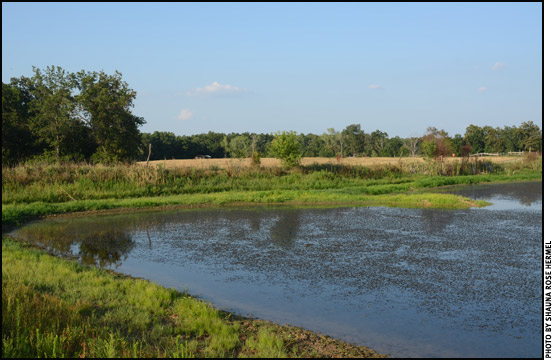
Hot, Dry Weather Boosts Likelihood
of Blue-Green Algae
K-State specialists issue new fact sheet, review steps for proper testing.
This summer's searing heat is causing a host of problems for landowners, including the threat of toxic cyanobacteria, also known as blue-green algae, on lakes and ponds.
"Blue-green algae can sicken or kill livestock and other animals, and also poses a threat to humans," said Carol Blocksome, Kansas State University (K-State) research assistant professor in agronomy. "If blue-green algae are suspected, a water sample can be collected and sent to the Kansas State Veterinary Diagnostic Laboratory."
Blocksome, who is a range management specialist with K-State Research and Extension, collaborated with K-State colleagues Deon van der Merwe and Larry Hollis to produce a fact sheet, "Identification and Management of Blue-green Algae in Farm Ponds," which is available online at www.ksre.ksu.edu/library/h20ql2/mf3065.pdf. Van der Merwe is a veterinary toxicologist with K-State's College of Veterinary Medicine, and Larry Hollis is a beef veterinarian with K-State Research and Extension.
Some of the tips in the fact sheet include:
- Take a sample where the algae is more likely to be present, such as the downwind side of a pond, and shallow areas that are warmer.
- Choose a clean container with a wide mouth. Rinse out the container with the pond water. Label the outside with the date and location.
- Scoop the water from the surface along with the scum. Be careful not to come into contact with the water. Avoid contact by using a cup attached to a long stick, or by using gloves.
- Secure the lid, and put the sample into a plastic bag. Put the sample into a cooler with an ice pack, but don't freeze.
- Place the sample in a refrigerator, and then mail it by overnight express to the lab of choice. One option is the K-State Veterinary Diagnostic Laboratory, Mosier D-117, 1800 Denison Ave., Manhattan, KS. 66506-5601. More information about the KSU Diagnostic Lab is available online at www.vet.k-state.edu/depts/dmp.
More information about blue-green algae is available on the Kansas Department of Health and Environment website, www.kdheks.gov/algae-illness/index.htm; in a related news release available at www.ksre.ksu.edu/news/story/bluegreen_algae062012.aspx; and in a video that can be found at http://youtu.be/ZRNWzFwKKjE.

[Click here to go to the top of the page.]









